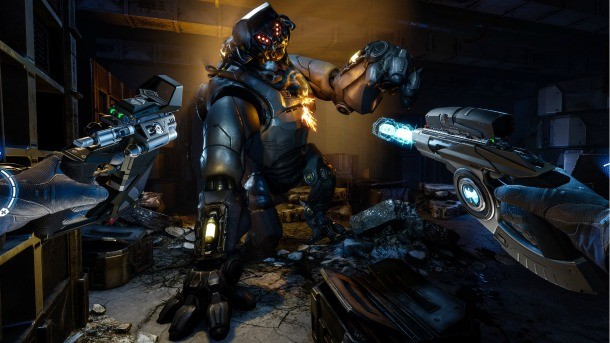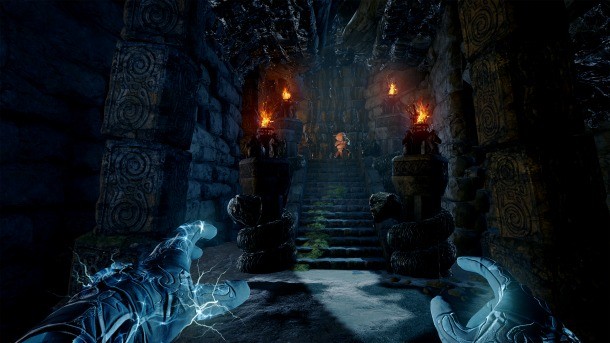The Best Virtual Reality Games Of GDC 2017

With all three major virtual reality platforms heading into their second year, 2017 is a critical one for filling out the game libraries and driving adoption for the nascent technology. An avalanche of games for Vive, Rift, and PSVR are all over the Game Developers Conference, so we've picked through the bunch to identify the most promising experiences coming to the platforms. One critical point to note with the titles on this list: these aren't bite-sized demos like the vast majority of the first wave of VR games. Most of these are full-fledged titles offering dozens of hours of play, cooperative play, or competitive multiplayer.
From Other Suns
Platform: Oculus Rift
Developer: Gunfire Games
Release: Fall
Part FTL, part Borderlands, this three-player co-op shooter gives players control of their own spaceship and tasks them with gathering resources for a fight against an intergalactic threat trying to eradicate the human race. Players choose which star system to jump to next, and will have to man the various ship stations to power up the shields, fire cannons on hostile ships, and repair damage done during the combat. Once the coast is clear, the trio can teleport to the nearby planet or space station to gather valuable resources.
The mission we played took place on a mining facility where a firmware update caused the robots to turn hostile. Blasting through the enemies and exploring the station yielded a variety of weapons, from autopistols and rifles to shotguns and pulse rifles. The various locations in the game have critical resources like repair materials, weapon upgrades, and additional crew members.
Gunfire Games says each level is procedurally generated, and it should take 15-20 hours to get through one playthrough. Look for From Other Suns on Oculus Rift later this year.

Mage’s Tale
Platform: Oculus Rift, other platforms TBD
Developer: InXile Entertainment
Release: Summer
This Oculus Touch-powered first-person dungeon crawler from the RPG experts at inXile puts you in the robes of a budding sorcerer. Taking place in the Bard’s Tale universe, you must delve deeper into the catacombs to save your master from the evil wizard Gaufroi. A variety of goblins, ghosts, and major bosses roam these halls, and each combat scenario creates a puzzle of sorts for you to solve. If the enemy is blocking all inbound spells with their shield, perhaps you need to craft a bouncing fire spell that can ricochet off walls to hit it from behind or use a guided ice javelin that can be navigated past the shield.
As you explore the nooks and crannies of these ruins, you come across valuable resources you can send back to your cauldron to craft more powerful spells. More than 30 ingredients can be combined in a variety of ways to make your fire, ice, wind, and lightning spells more devastating. An RPG leveling system offers you a choice of two upgrades each time you raise a rank, giving you more health or mana, or perhaps the ability to make a large shield to deflect powerful spells.
Mage’s Tale has 11 dungeons to explore, so it won't be a bite-sized experience like the early wizard games on VR platforms.
Arktika.1
Platform: Oculus Rift
Developer: 4A Games
Release: Fall
The minds behind the spectacular Metro series is jumping into VR with another apocalyptic shooter. Arktika.1 trades the nuclear fallout for a silent apocalypse brought on by an ice age. Only a few pockets of society remain in the harsh conditions, and these heavily fortified outposts are the constant target of marauding survivors. You are brought on as a member of Citadel Security to defend the perimeter and discover the other threats surrounding the enclave.
Graphically, Arktika.1 ranks right up there with Robo Recall as the best-looking VR games we’ve seen to date. Developer 4A Games has always delivered highly atmospheric experiences, and Arktika.1 is no exception. The first-person shooter uses many of the same conventions as other emerging games, using teleportation for navigating environments and allowing you to reload by pointing your guns at the ground. The level we saw had the hero venturing into a frozen wasteland, engaging in firefights in a downed airplane and a derelict airport. Cover appears to be a key component to surviving, as the enemies are formidable.
Though we only got a small glimpse of the game, it has an interesting narrative underpinning, an intriguing setting begging to be explored, and promising combat with a wealth of weapon upgrades players can acquire. This is the type of VR title hardcore gamers have been waiting for.
Brass Tactics
Platform: Oculus Rift
Developer: Hidden Path Entertainment
Release: October
Defense Grid 2 developers Hidden Path Entertainment is back with another VR real-time strategy game. This medieval fantasy setting almost looks like the clockwork map from the Game of Thrones title sequence come to life. Players spend currency to reinforce their base, build new structures and create new units to conquer the map before them. The PvP map we played featured a classic three-lane layout, with several towers available for capture where you can place new structures.
The controls are intuitive enough that I felt comfortable after playing for a few hours. Grabbing the table in front of you and flicking the Touch controller was the fastest way for zooming around the map, and the one-touch button makes it easy to grab several units at once to direct them to attack a position on the map.
Hidden Path says Brass Tactics has five campaign missions with a variety of different map designs. Players can also team up for cooperative play with specially designed maps.
Sparc
Platform: PSVR, Oculus Rift, Vive
Developer: CCP Games
Release: 2017
CCP typically focuses its development efforts on its Eve universe, but it's stepping out of its comfort zone with Sparc. This one-on-one sports game gives each player a ball in a tight corridor space and challenges them to hit the other player to rack up points. Defenders can dodge, use a shield to block, or punch back the oncoming attack, and attackers can apply English to the ball or use the walls to come at the defender from different angles. You can score against your opponent either by hitting them with either ball.
With simple motion controls, Sparc is easy to pick up. You simply hold the trigger on either controller to catch the ball or block it with your shield, and a regular throwing motion sends the ball hurling back the other direction. Even if you aren't scoring, you can increase the size and velocity of your ball by throwing "strikes," which is essentially landing shots in the target window of the opposing person's torso. The more strikes you throw, the bigger and faster the ball gets. CCP plans to include trials and challenges to help players hone their accuracy and reaction timing.
Once you get the hang of the game, you can jump from beginner mode to pro mode. This higher tier of competition removes the knuckle guards that allow you to punch back oncoming balls, making dodging a more crucial part of defense.
CCP wants to preserve the balance of competition, so Sparc doesn't include any game-altering progression or upgrades. However, you can unlock new customization options as you play more. A spectator mode allows players to watch competitions from a side view.
Sparc sounds simple enough, but in practice I can see how this virtual sport could be a destination for VR players. Its simple control scheme opens up the game to anyone who can stand some light exercise, and the cross platform support between Vive and Rift should help foster a competitive community.

Get the Game Informer Print Edition!
Explore your favorite games in premium print format, delivered to your door.
- 10 issues per year
- Only $4.80 per issue
- Full digital magazine archive access
- Since 1991









